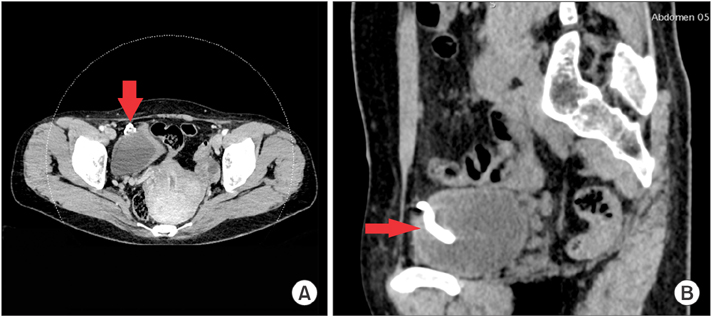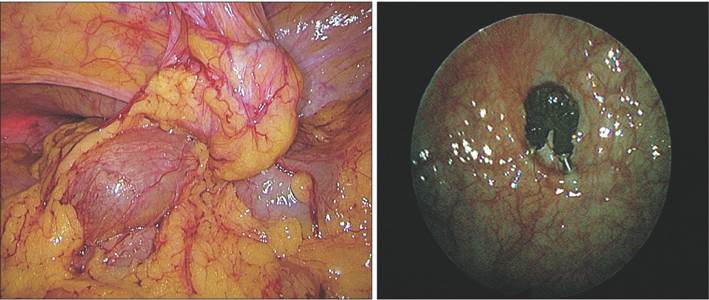Investig Clin Urol.
2016 Nov;57(6):449-452. 10.4111/icu.2016.57.6.449.
Removal of foreign bodies embedded in the urinary bladder wall by a combination of laparoscopy and carbon dioxide cystoscopic assistance: Case report and literature review
- Affiliations
-
- 1Department of Urology, Peking University First Hospital, Institute of Urology, Peking University, Urogenital Diseases (Male) Molecular Diagnosis And Treatment Center, National Research Center for Genitourinary Oncology, Beijing, China. jinjie_pku@yeah.net
- KMID: 2451405
- DOI: http://doi.org/10.4111/icu.2016.57.6.449
Abstract
- PURPOSE
To report a case of combined laparoscopic and carbon dioxide partial cystectomy and foreign body removal and to review the existing literature on the topic.
MATERIALS AND METHODS
A 43-year-old Asian woman was found to have an intrauterine device embedded in the bladder wall during evaluation for chronic pelvic pain and urinary tract infection. She underwent cystoscopic-laparoscopic partial cystectomy, with an uncomplicated postoperative course. She had normal renal function during the follow-up period. This case demonstrates the possibility and safety of performing cystoscopic-laparoscopic partial cystectomy for the removal of a partially implanted intravesical foreign body.
RESULTS
The patient recovered without incident and was discharged 7 days after surgery. No abnormalities were noted in the urine output or renal function in the postoperative follow-up period. No complications due to retrograde flow of carbon dioxide up the ureters or air embolism were noted during the procedure or postoperatively.
CONCLUSIONS
The combination of laparoscopy and air cystoscopy has been shown to be an optimal method for retracting foreign bodies embedded in the bladder wall. Also, air cystoscopy can be used to give doctors a better view in cases in which vision is compromised under water-contrast cystoscopy.
MeSH Terms
-
Adult
Carbon Dioxide
Cystectomy/methods
Cystoscopy/*methods
Device Removal/methods
Female
Foreign Bodies/diagnostic imaging/etiology/*surgery
Foreign-Body Migration/diagnostic imaging/surgery
Humans
Intrauterine Devices/*adverse effects
Laparoscopy/*methods
Tomography, X-Ray Computed
*Urinary Bladder/diagnostic imaging
Urinary Bladder Calculi/diagnostic imaging/etiology/surgery
Carbon Dioxide
Figure
Reference
-
1. Rafique M. Intravesical foreign bodies: review and current management strategies. Urol J. 2008; 5:223–231.2. Dietrick DD, Issa MM, Kabalin JN, Bassett JB. Intravesical migration of intrauterine device. J Urol. 1992; 147:132–134.3. Mustafa M. Erosion of an intrauterine contraceptive device through the bladder wall causing calculus: management and review of the literature. Urol Int. 2009; 82:370–371.4. Shin DG, Kim TN, Lee W. Intrauterine device embedded into the bladder wall with stone formation: laparoscopic removal is a minimally invasive alternative to open surgery. Int Urogynecol J. 2012; 23:1129–1131.5. Hajós L, Szüle E. Pneumocystoscopy. Z Urol Nephrol. 1971; 64:129–130.6. Matthews PN, Skewes DG, Kothari JJ, Woodhouse CR, Hendry WF. Carbon dioxide versus water for cystoscopy: a comparative study. Br J Urol. 1983; 55:364–366.7. Parazajder J, Krivec O, Radej M, Kovacić M. Air as an optic medium in diagnostic cystoscopy. Acta Chir Iugosl. 1977; 24:1 Suppl. 481–483.8. Reddy BS, Daniel RD. A novel laparoscopic technique for removal of foreign bodies from the urinary bladder using carbon dioxide insufflation. Surg Laparosc Endosc Percutan Tech. 2004; 14:238–239.9. Eyraud R, Laydner H, Autorino R, Panumatrassamee K, Haber GP, Stein RJ. Robot-assisted laparoscopic bladder diverticulectomy. Curr Urol Rep. 2013; 14:46–51.
- Full Text Links
- Actions
-
Cited
- CITED
-
- Close
- Share
- Similar articles
-
- A Case of Foreign Body Granulomatous Reaction to a Red Lip Cosmetic Tattoo Successfully Treated with Carbon Dioxide Laser
- Laparoscopic Removal of a Broken Sewing Needle in a Patient with Irritative Bladder Symptoms
- 14 Cases of Foreign Bodies in the Bladder
- Unusual Foreign Bodies in the Urinary Bladder and Urethra Due to Autoerotism
- A Case of Bladder Stone and Vesicovaginal Fistula after McDonald Operation




